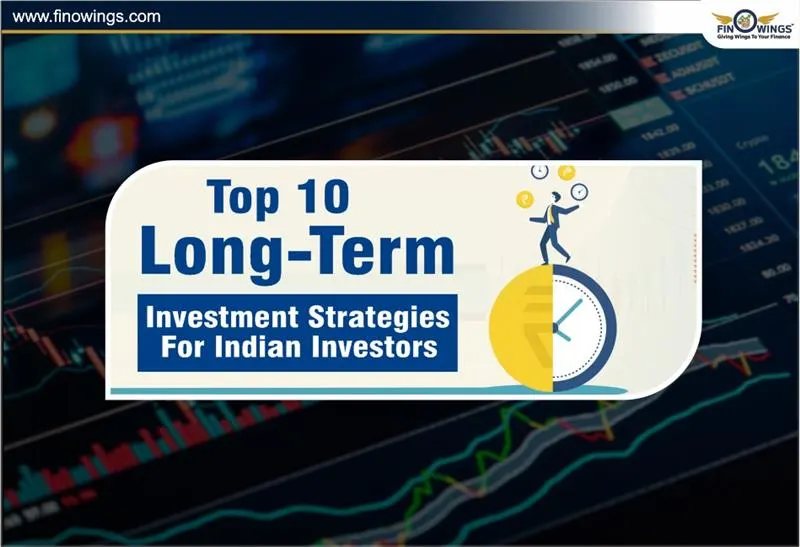Home >> Blog >> Investing in India: A Beginner's Guide
Investing in India: A Beginner's Guide

Table of Contents
- Investing in India: A Beginner's Guide
- Demographic Dividend
- Why Invest in Indian’s Stock Market?
- Mutual Fund India - The Simplified Way to Invest
- Why Mutual Funds Are Popular in India
- Long term Investment India – Key Principles
- Investment Strategies for Different Investor Types
- Stock Market India vs Mutual Fund India: Key Comparison
- Taxation on Investments
- Smart Investing for 2025
- India’s Predictions on Global Investments
- Conclusion
Investing in India: A Beginner's Guide
India’s GDP growth has been among the highest in the major economies continuously. The Indian economy is expected to grow at around 6-7% in 2025 and beyond. That’s why it should be said that the Indian economy is presenting certain long-term opportunities for both domestic and international investors.
Making educated judgments as an investor requires knowing the ins and outs of the Indian stock and mutual fund markets, regardless of experience level. The best ways to invest in India, long-term investment strategies, be in the Indian stock market or a mutual fund, and the major industries influencing the country's financial destiny may all be explored with the aid of this thorough guide.
Demographic Dividend
Given that over 60% of the population is under 35, there is a steady need for innovation, start-ups, and consumption in the Indian market.
Government Reforms and Digital Push
For the growth of both manufacturing and fintech sectors, several schemes and smart campaigns, to mention a few, involving Make in India, Digital India, have been implemented. All of the changes provide a positive outlook for India’s stock market.
Rising Retail Participation
With new investors flooding into the market through SIPs (Systematic Investment Plans) and online platforms, mutual funds and direct equities have become mass market financial assets for the Indian middle class.
India’s Retail Investor Boom
Millions of new investors are entering the market through SIPs (Systematic Investment Plans) and online platforms. For middle-class India, mutual funds and direct equities are now mainstream financial instruments.
Indian Stock Market
There are over 5,000 corporate entities listed on the National Stock Exchange of India, also referred to as the BSE (Bombay Stock Exchange).
Why Invest in Indian’s Stock Market?
-
Equity, long-term investment, any unit can be out of stock, in the end.
-
You can buy and sell shares in the world’s primary stock exchange.
-
There are many companies that regularly share their profits.
-
Participate in the growth of India. As the country advances, you are part of the journey.
Risks that Must be Kept a Watch for
-
Unstable Stock Markets.
-
Particular risks of the industry.
-
Notably, global and domestic financial crises.
According to our article, diversified investing and discipline are the secrets to a good long-term investment in India.
Mutual Fund India - The Simplified Way to Invest
Not everyone has the luxury of time to do their own research and invest in individual stocks. Mutual funds are the solution to this. Mutual fund India channels money from various investors and invests in stocks, bonds, etc.
Types of Mutual Funds in India
|
Fund Type |
Investment Objective |
Ideal For |
|
Equity Mutual Funds |
Long-term wealth creation through stocks |
High-risk investors |
|
Debt Mutual Funds |
Stable income through bonds and securities |
Conservative investors |
|
Hybrid Funds |
Mix of equity + debt |
Balanced approach seekers |
|
ELSS Funds |
Tax-saving + equity exposure |
Salaried investors under 80C |
|
Index Funds/ETFs |
Passive investing following indices |
Low-cost long-term investors |
Why Mutual Funds Are Popular in India
1. Diversification: Invest in many companies to lower risk
2. Professional Management: The fund portfolio is closely monitored by expert fund managers.
3. SIPs (Systematic Investment Plans): Indian mutual funds are the way to start as low as Rs. 500/month.
4. Tax Efficiency: Tax benefits can be availed on investments in ELSS MFs under 80C.
5. Transparency: Thoughts on Airline Women
Mutual funds are most people’s best bet for investing in India without wading through the complexities of financial numbers in order to make a judgment on the best stock.
Example: Power of SIP in Long-Term India Investment
Suppose you have been investing Rs. 10,000 per month for 20 years in an equity-oriented mutual fund, you’ll accumulate Rs. 24 lac over 20 years, but you’ll have Rs. 99 lac+ at the end. The point is, India's long-term investment through SIP is the way to go if you want to be a free fitter person in the next 20 years.
Other Investment Options in India
Diversify into other instruments, with stocks and mutual funds.
Public Provident Funds (PPF)
Savings with government guarantee + tax-free interest + 15-year lock-in, making PPF an ideal retirement planning tool.
National Pension System (NPS)
80CCE of the Indian income tax allows you to avail tax benefits in the amount of Rs. 2 lac.
Gold and Sovereign Gold Bonds
Gold is an inflation hedge and has preserved wealth for centuries.
Long term Investment India – Key Principles
Long term investment in India must remain focused on long term investment strategies and not speculative short-term investments.
Golden rules of long-term investment in India:
Start Early
If you start investing as early as your late teens, you will enjoy the magic of compounding interest. Even very small contributions, such as a Rs. 50 investment every month can grow into a staggering fortune over the decades.
Diversify
Hedge your bets across a range of unrelated opportunities or asset classes such as stocks on the stock market, exchange-traded funds, and real estate funds. Various mutual funds and the safe ones true businessmen put their money in, for instance, are PPF and NPS.
Stay Invested Through Volatility
Markets are predicted to fluctuate significantly in the short term; don’t be afraid to be a long-term investor. Recent past Nifty 50 companies' charges (NSE: BSE). They have survived over dozens of market collapses in the past- this provides you with peace of mind.
Reinvest Dividends
Sophisticated investors purchase dividend stocks that pay dividends in cash. They then use that profit to buy good stocks. They add their dividends to investments, potentially making more money on top of what they would have made.
Review Periodically
Review and reset your overall allocation of investments in your asset class once a year and whenever necessary.
Avoid Emotional Decisions
Investment research and decision-making should be grounded in what works. Don’t invest based on emotions but rely on what works best.
Investment Strategies for Different Investor Types
|
Investor Type |
Goal |
Recommended Strategy |
|
Beginner |
Learn basics, build a habit |
Start SIPs in index or hybrid funds |
|
Salaried Professional |
Build wealth & save tax |
ELSS, PPF, and equity funds |
|
Aggressive Investor |
High growth |
Direct stocks + mid/small-cap mutual funds |
|
Conservative Investor |
Stability & income |
Debt funds, PPF, gold |
|
Retiree |
Regular income |
SWP (Systematic Withdrawal Plan) + bonds |
Stock Market India vs Mutual Fund India: Key Comparison
|
Feature |
Stock Market India |
Mutual Fund India |
|
Management |
Self-managed |
Professionally managed |
|
Risk Level |
High |
Moderate to low (diversified) |
|
Return Potential |
High |
Consistent over the long term |
|
Knowledge Required |
High |
Minimal |
|
Investment Size |
Flexible |
As low as Rs. 500 SIP |
|
Best Suited For |
Experienced investors |
Beginners & busy professionals |
Taxation on Investments
|
Investment Type |
Taxation Details |
|
Equity Stocks |
Short-term (holding < 12 months): 15% tax on gainsLong-term (> 12 months): 10% tax above Rs. 1 lac profit |
|
Mutual Funds – Equity Funds |
Same as equity stocks |
|
Mutual Funds – Debt Funds |
Taxed as per the income slab (no indexation from 2023 onwards) |
|
Mutual Funds – ELSS Funds |
Tax benefits under Section 80C |
Understanding these will help you assess the viable post-tax returns for some of the long-term investments India has to offer.
Smart Investing for 2025
-
Use Systematic Investment Plans (SIPs) and Systematic Transfer Plans (STPs) to help you automate your investments.
-
Use apps like Groww, Zerodha, or Upstox to help you invest.
-
Remain mindful of inflation, interest rates, and GDP as these elements will affect your investments.
-
Remain focused on the value of an asset and avoid the hype.
-
Be in the loop of RBI statements, budget changes, and SEBI guidelines.
India’s Predictions on Global Investments
India is predicted to be the 3rd largest economy in the world by 2030. Investors of the world are investing heavily in India in these areas:
-
Green Energy
-
Digital Infrastructure
-
EV Manufacturing
-
Semiconductors
-
Healthcare & India Pharmaceuticals
These investments are predicted to grow personal wealth and contribute to the nation’s economy. Investing in India will grow and change the nation.
Conclusion
Regardless of whether you select mutual funds or the stock market in India, the core principle should be consistency, diversification, and long-term vision. With the digital economy rapidly growing, along with the investor base, India provides unparalleled financial opportunities.
Begin with index investing or SIPs early on, compounding will benefit long-term investments in India, to ensure safety, diversify among different classes and constantly learn and be disciplined.
DISCLAIMER: This blog is NOT any buy or sell recommendation. No investment or trading advice is given. The content is purely for educational and information purposes only. Always consult your eligible financial advisor for investment-related decisions.
Author
Frequently Asked Questions
Beginners can start by investing through SIPs in mutual funds (especially index funds or hybrid funds), as they require low capital, are professionally managed, and reduce risk through diversification. Platforms like Groww, Zerodha, and Upstox make it easy to begin.
The Indian stock market is safe if you follow principles like diversification, long-term investing, using stop-loss in stocks, and avoiding emotional decisions. Beginners who lack market knowledge should start with mutual funds before picking individual stocks.
Popular long-term investment options include equity mutual funds, ELSS, index funds, PPF, NPS, stocks of fundamentally strong companies, and Sovereign Gold Bonds (SGBs). These options offer compounding, tax benefits, and lower volatility over time.
You can start investing in India with as little as ₹500 per month through SIPs. Even stock market investing can begin with small amounts, but beginners should focus on mutual funds until they gain experience.
New investors should be mindful of market volatility, economic uncertainties, sector-specific risks, and emotional decision-making. Diversification, regular portfolio reviews, and investing for the long term help reduce overall risk.


















